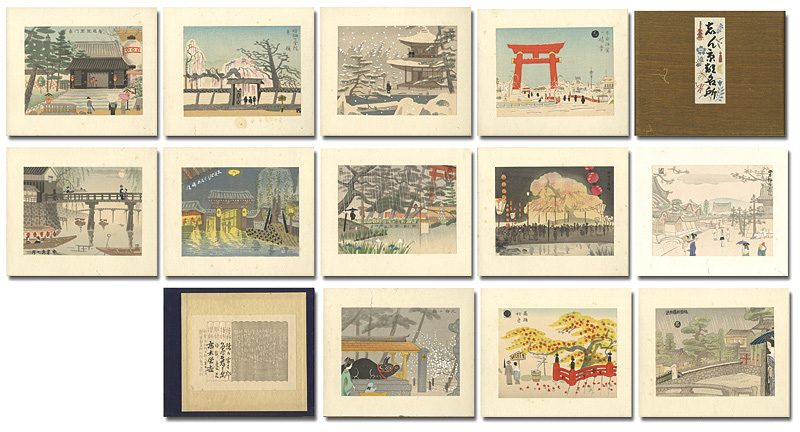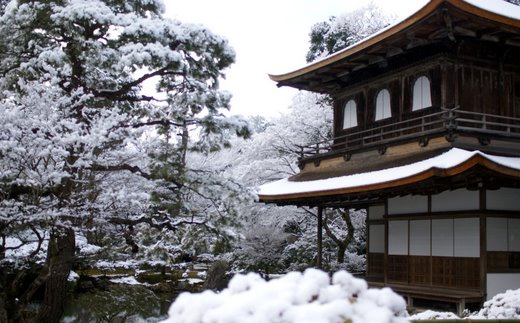About This Print
One of twelve small-size prints (approx. 5 x 6.5 in.) from the portfolio titled New Famous Places of Kyoto (志ん京都名所 Shin Kyōto meisho), designed by the artists Kamei Tōbei (1901-1977) and Tokuriki Tomikichirō (1902-2000)*, and published by the New Famous Places of Kyoto Publication Society (新京都名所刊行会).
The two artists often collaborated and the publishing entity New Famous Places of Kyoto Publication Society, is likely a construct of the two artists.
* It is unclear if Tokuriki actually designed any of the prints themselves as all the prints carry some version of Kamei's artist seal.
This print depicts a woman and her child peering down on a priest from the terrace of the Silver Pavilion on a snowy day.
* It is unclear if Tokuriki actually designed any of the prints themselves as all the prints carry some version of Kamei's artist seal.
The Complete Portfolio
Six or more of the print designs in this portfolio seem to have also been issued at another time, possibly printed using different blocks. The website of The Agency of Cultural Affairs - Cultural Heritage Online contains six of these prints, with each print visibly different from the prints in this collection. As with this collection's prints, their prints are not dated, but they attribute the prints to Kamei Genbei, a name used by Kamei after 1953, which helps narrow the publication dates to post-1953.
Ginkaku-ji
Source: japan-guide.com http://www.japan-guide.com/e/e3907.html
Ginkakuji (銀閣寺, Silver Pavilion) is a Zen temple along Kyoto's eastern mountains (Higashiyama). In 1482, shogun Ashikaga Yoshimasa built his retirement villa on the grounds of today's temple, modeling it after Kinkakuji (Golden Pavilion), his grandfather's retirement villa at the base of Kyoto's northern mountains (Kitayama). The villa was converted into a Zen temple after Yoshimasa's death in 1490.
As the retirement villa of an art obsessed shogun, Ginkakuji became a center of contemporary culture, known as the Higashiyama Culture in contrast to the Kitayama Culture of his grandfather's times. Unlike the Kitayama Culture, which remained limited to the aristocratic circles of Kyoto, the Higashiyama Culture had a broad impact on the entire country. The arts developed and refined during the time include the tea ceremony, flower arrangement, noh theater, poetry, garden design and architecture.
Today, Ginkakuji consists of the Silver Pavilion, half a dozen other temple buildings, a beautiful moss garden and a unique dry sand garden. It is enjoyed by walking along a circular route around its grounds, from which the gardens and buildings can be viewed.
The first sight of the Silver Pavilion can be enjoyed shorty after entering the grounds. Formally named Kannonden (Kannon Hall), the pavilion's two stories are constructed in two different architecture styles and contain a statue of Kannon, the Buddhist goddess of mercy. However, the interior of the building is not open to the public.
Despite its name, the Silver Pavilion was never covered in silver. Instead, it is believed that the name arose as a nickname more than a century after the building's construction to contrast it with the Golden Pavilion. Alternatively, it is explained that moon light reflecting on the building's dark exterior (which used to be covered in black lacquer in the past) gave it a silvery appearance.
The pavilion is one of only two buildings on the grounds of Ginkakuji which have survived intact the many fires and earthquakes of the past centuries, although it has been undergoing periodical renovation works to keep it well preserved. Most recently the building's roof was redone and its earthquake resistance was improved. The works were completed in spring 2010.
Print Details
| IHL Catalog | #1124 |
| Title | Ginkaku-ji 銀閣寺雪景 |
| Series | New Famous Places of Kyoto 志ん京都名所 |
| Artist | Kamei Tōbei (1901-1977) |
| Signature | not signed |
| Seal |  |
| Date | after 1953 |
| Edition | unknown |
| Publisher | 新京都名所刊行会 New Famous Places of Kyoto Publication Society |
| Impression | excellent |
| Colors | excellent |
| Condition | fair - minor foxing; backed with stiff paper (likely the original mounting trimmed); rubbing with minor image loss |
| Genre | sosaku hanga (creative print) |
| Miscellaneous | |
| Format | yotsugiri |
| H x W Paper | 4 13/16 x 6 7/16 in. (12.22 x 16.35 cm) |
| Collections This Print | The Museum of Modern Art, Wakayama http://www.momaw.jp/search-db/heritage-list.php?&creatorName=%E4%BA%80%E4%BA%95&pageSize=20 |
| Reference Literature |
last updated:
10/13/2019




